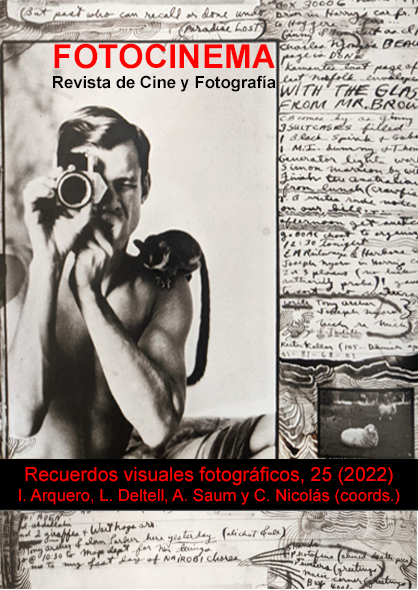Fictional tactics of memory. New narrative discourses in contemporary photography.
DOI:
https://doi.org/10.24310/Fotocinema.2022.vi25.14201Keywords:
Memory, Photography, Artistic creation, Fiction, IdentityAbstract
In the current context of affirmation of postphotographic theses and their challenge to traditional documentary values, photographs have lost their credibility as supposed objective units of knowledge. Even so, photographic images continue to be a powerful instrument for the analysis, understanding and critical interpretation of the world and an unrivaled graphic record of time –past and present– that constantly appeals to individual and collective memory. All narration implies a process of invention of reality itself that it aims to point out: sometimes, memory is just a reflection, a mirage or an illusion of experiences, or an ideal construction that helps people images of his own amnesia. This article investigates some of these fictional memory tactics in contemporary photography.
Downloads
Metrics
References
Baden, K. (2014). Work for two bodies. Blue Sky Books.
Casas, A. (2000). Álbum. Mestizo.
Dean, T., & Ridgewell, M. (2002). Floh. Steidl Publications.
De Middel, C. (2016). Muchismo. La Fábrica.
Doctor, R. (2002). Historias de las fotografías. Caja Madrid Obra Social.
Doctor, R. (2019). El juego perfecto. Archivo Rastro. Recuperado el 29 de enero de 2022 de https://www.archivorastro.com/
Dubois, P. (1986). El acto fotográfico. De la Representación a la Recepción. Paidós.
Fontcuberta, J. (1997). El beso de Judas. Fotografía y verdad. Gustavo Gili.
Fontcuberta, J. (2010). La cámara de Pandora. La fotografí@ después de la fotografía. Gustavo Gili.
Fontcuberta, J. (2016). La furia de las imágenes. Notas sobre la postfotografía. Galaxia Gutenberg.
Gómez, P. (2020). Wattebled o el rastro de las cosas. Fracaso Books.
Halbwachs, M. (2004). Los marcos sociales de la memoria. Anthropos.
Halbwachs, M. (2004) La memoria colectiva. Prensas Universitarias de Zaragoza.
Hirsch, M. (1997). Family Frames. Photography narrative and postmemory. Harvard University Press.
Kuhn, A. (2002). Familiy Secrets. Acts of Memory and Imagination. Verso.
Kuhn, A., y McAllister, K.E. (2006). Locating Memory. Photographic Acts. Berghahn Books.
Lister, M. (1997). Ensayo introductorio. En M. Lister, La imagen fotográfica en la cultura digital (pp. 13-45). Paidós.
Marzo, J. L. (2018). La competencia de lo falso. Una historia del fake. Cátedra.
Nora, P. (2008). Les lieux de mémoire. Trilce.
Ramos, Y. (2020). Show me, Know Us, Welcome Her. Centro Atlántico de Arte Moderno.
Ritchin, F. (2008). After Photography. W. W. Norton & Company.
Sontag, S. (1980). Sobre la Fotografía. Edhasa.
Soutif, D. (1988). Et in Boltanskia Ego. En C. Boltanski, El Caso (pp. 10-25). Centro de Arte Reina Sofía.
Tillmann, U., y Vollmer, W. (1985). Meisterwerke der Fotokunst. Wienand Verlag.
Downloads
Published
How to Cite
Issue
Section
License
All contents published in Fotocinema Revista científica de cine y fotografía are protected under the Creative Commons Attribution-NonCommercial-ShareAlike 4.0 International (CC BY-NC-SA 4.0) license. All about this license is available in the following link: <http://creativecommons.org/licenses/by-nc-sa/4.0>
Users can copy, use, redistribute, share and exhibit publicly as long as:
- The original source and authorship of the material are cited (Journal, Publisher and URL of the work).
- It is not used for comercial purposes.
- The existence of the license and its especifications are mentioned.
There are two sets of authors’ rights: moral and property rights. Moral rights are perpetual prerogatives, unrenounceable, not-transferable, unalienable, imprescriptible and inembargable. According to authors’ rights legislation, Fotocinema. Revista científica de cine y fotografía recognizes and respects authors moral rights, as well as the ownership of property rights, which will be transferred to University of Malaga in open access. The property rights are referred to the benefits that are gained by the use or the dissemination of works. Fotocinema. Revista científica de cine y fotografía is published in an open access form and it is exclusively licenced by any means for doing or authorising distribution, dissemination, reproduction, , adaptation, translation or arrangement of works.
Authors are responsable for obtaining the necessary permission to use copyrighted images.













13.png)




